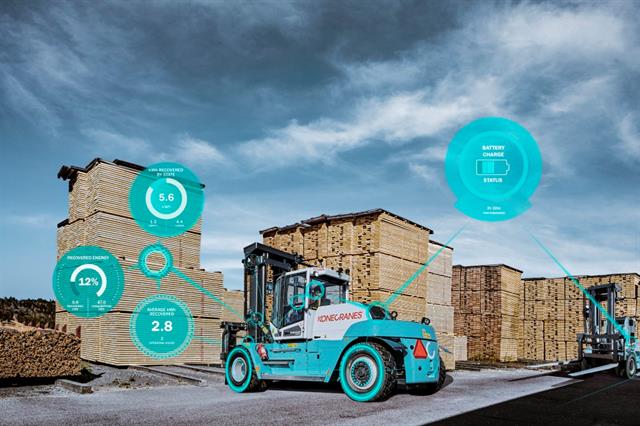
There are different methods to store electric energy. One of them is the battery. When talking about batteries for electric forklift trucks, depending on which type of battery being used, it can have a major impact on the overall efficiency and endurance.
There are predominantly two types of battery technologies powering electric forklifts: lead-acid and lithium-ion. The Konecranes award-winning electric forklift E-VER for example runs on a lithium-ion battery. This type of machine is becoming more and more common in our marketplace and will take a big share of the future product landscape.
Experience the Next Generation of Lift Trucks - Moelven Edanesangen AB
Lithium-ion batteries
“One of the main benefits of using lithium-ion batteries is that they can be recharged much faster than lead-acid batteries. Equipped with this kind of batteries, our electric forklift trucks are much more flexible in operation, as they can benefit from short charging periods,” says Jörn Albers, Senior System Engineer, Lift Trucks, Konecranes. “Besides, these lift trucks are able to save energy while braking: The braking energy is recovered and recharges the battery, much more effectively than with lead-acid batteries.”
Li-ion electric forklifts can be designed to take advantage of the higher battery voltage compared to lead-acid, resulting in lower electrical currents and therefore less power losses.
“Another important point is safety. When talking about high-voltage batteries, as the ones used by the Konecranes E-VER electric forklifts, the lithium-ion batteries are considered much safer compared to lead-acid batteries since they do not pose as many health hazards for those working with them”, says Anders Nilsson, Technology Director, Lift Trucks, Konecranes. “These batteries are completely sealed. There is no need to open them for watering, reducing the risk of electrolyte spills or explosive fumes for example.”
Risk of battery fire might be another concern for future users. This risk is minimized by design, such as a battery management system (BMS) that maintains and monitors each battery cell, and several layers of battery encapsulation to protect from physical damage.
Also, the active thermal management ensures that the battery does not become too hot or cold, meaning that the Li-ion batteries are always well maintained. This allows for a high power but is also highly beneficial for a longer battery lifetime. Another major advantage is that the drivers cabin thermal preconditioning can be done in parallel while the battery is on charge.

Environmental impact
The environmental impact is something that customers are concerned about. This is often driven by requirements posed by the customers themselves or legislation. Battery electric forklift trucks, being the only feasible tank-to-wheel zero emission technology, are outperforming internal combustion engine powered forklifts in almost all comparisons: energy efficiency, productivity, driver’s comfort, noise emission, maintenance etc.
Due to the excellent lifetime of Li-Ion batteries, at least double when comparing to lead-acid batteries, there is normally no need to replace Li-ion batteries in the lifetime of the machine.
Battery as a Service
To reduce CAPEX, Capital Expenditure, need and thus make the purchase decision easier for the customers, Konecranes offers Battery as a Service (BaaS), an innovative business model to facilitate financing and support our customers of the E-VER range of Li-Ion powered electric forklift trucks.
Through BaaS, Konecranes provides rechargeable and remotely monitorable Li-ion batteries to its BaaS users. This will allow the customers to purchase an E-VER electric heavy forklift without battery and to buy as a service the most suitable battery for its need. The battery is subscribed to a monthly fee, based on its actual usage which can be monitored in real-time at the yourKONECRANES.com customer portal. The battery becomes an OPEX, Operational Expenditure. Konecranes guarantees the optimal performance of the battery.
BaaS also eliminates financial uncertainties due to matters such as battery degradation, and lower resale value due to this. This service keeps the machine resale value independent from the battery state of health.

Future technology
Technology is constantly evolving. If we look into future technology, we have the Fuel Cell Electric vehicle (FCEV) concept, which uses a hydrogen powered fuel cell that generates electricity to power the electric truck. Tank-to-wheel emissions become water only. As of today, this technology is not yet commercially ready to come to our workplace, but this is expected to change.
New technologies are also reducing the environmental impact from the internal combustion engine. While drop-in fuels like HVO100 and e-fuels do not significantly reduce the tailpipe emissions of a diesel engine powered truck, the overall well-to-wheel emissions can be reduced by more than 70%. Then, internal combustion engines can also be designed to operate on hydrogen, which will reduce the tailpipe CO2 emissions by 60-80%. Converting a diesel engine powered truck to dual-fuel hydrogen/diesel operation can be an interesting retrofit.
For more information, please contact us!

Konecranes Lift Trucks
Phone: +46 433 73300
Get in contact
Social Media: Facebook | LinkedIn | Twitter | YouTube